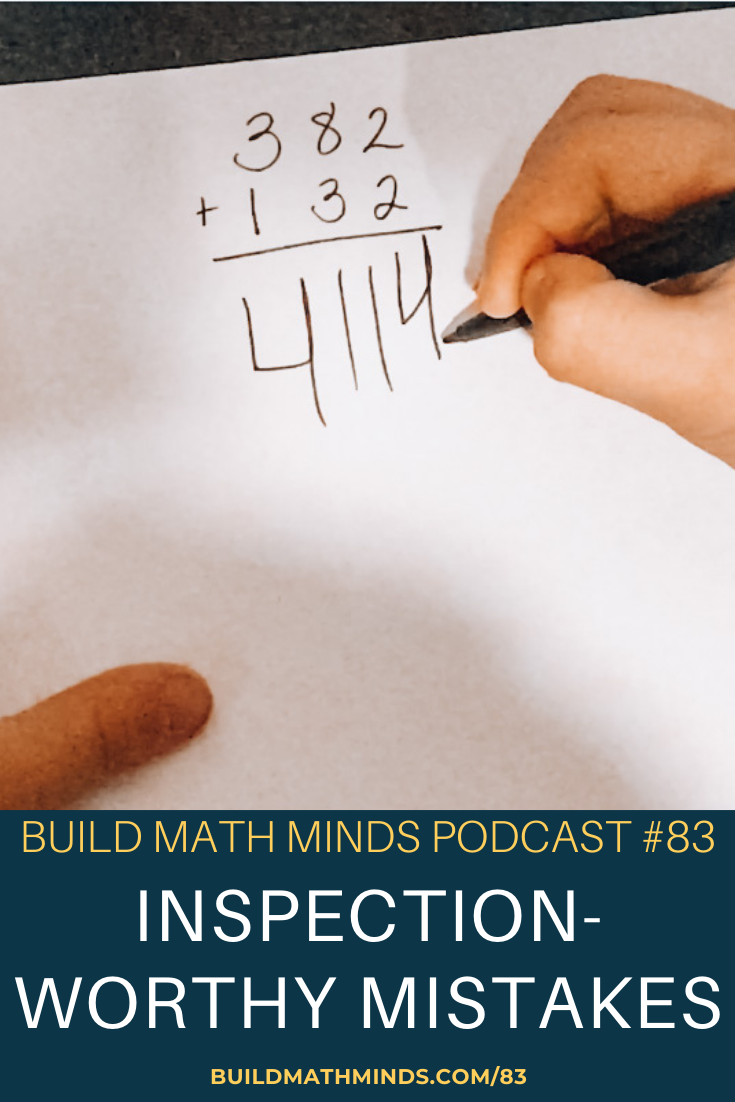Resources mentioned in this episode:
Inspection-Worthy Mistakes: Which? And Why? By Angela T. Barlow, Lucy A. Watson, Amdeberhan A. Tessema, Alyson E. Lischka, and Jeremy F. Strayer
Become a member of the Build Math Minds PD site
Welcome fellow Recovering Traditionalists to Episode 83. Today we are looking at Inspection-Worthy Mistakes.
A few podcasts ago, in episode 81, I talked about kids feeling like they are just bad at math. One of the things that builds that feeling is that we look at mistakes in math as errors that shouldn’t happen instead of looking at them as opportunities for learning and growth.
Now don’t get me wrong, we do want kids to get correct answers, but kids are going to make mistakes and get wrong answers, that’s just a fact of life. There are mistakes that are just calculation errors. Like sometimes when I see 3 x 2, I think 5 instead of 6. That is just an error. But some mistakes can tell us a lot about our students’ thinking around mathematics and can be great things to bring to the whole class to discuss so that everyone can learn from the mistake.
However, do you stop class every time you see a mistake to have a whole group discussion?? No. But how do you decide what mistakes you should take time investigating? I used to think that if it was just a procedural mistake that it wasn’t worth investigating. But when I read the article Inspection-Worthy Mistakes: Which? And Why? By Angela T. Barlow, et al, they changed my mind. On page 386 they give us two guiding questions to determine if a procedural error is worth inspecting:
- Is the error pervasive or fairly common throughout the class? For example, consider a classroom of third-grade students who are practicing subtraction with three-digit numbers involving regrouping. As the teacher circulates around the room, she notices several students making the procedural error of subtracting the minuend from the subtrahend in the ones place (see g. 1a). Given that several students have made this procedural error, it is worthy of class inspection.
- Is the error in line with the lesson’s goals? Suppose, for example, a fifth-grade class has been studying multiplication with decimals when the teacher notices that a student has incorrectly placed the decimal in the product (see g. 1b) by “lining up the decimals” as
if it were an addition problem. Although the error is not necessarily pervasive, correct placement of the decimal in the product represents a fundamental component of the lesson’s goals and is, therefore, worthy of inspection.
Investigating mistakes in math class can help build student learning but at the end of the article, the authors make another good point that some students who are unwilling to discuss their own thinking about mathematics are willing to investigate and discuss other people’s mistakes. And as we’ve talked about on previous podcast episodes, there is a lot of benefit to getting students talking in math class.
The article goes into more detail about which mistakes are worth investigating and why you should investigate them. So I encourage you to go read it for yourself.
Subscribe and Review in iTunes
Hey, are you subscribed to the Build Math Minds Podcast, yet? If you’re not, make sure to do that today because I don’t want you to miss any episodes! Click here to subscribe to the podcast in iTunes.
While you’re there, don’t forget to leave a review on iTunes too. I would love to know your thoughts and how we can make sure that we give you content that you will really enjoy.
To leave a review, head over to iTunes and click on “Ratings and Reviews” and “Write a Review.” I can’t wait to hear your thoughts about the podcast.




